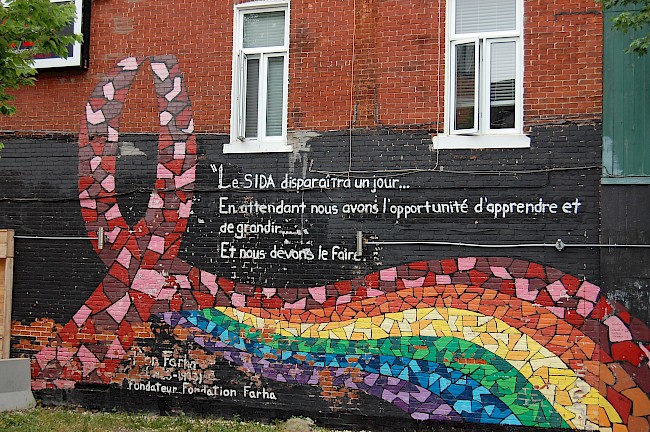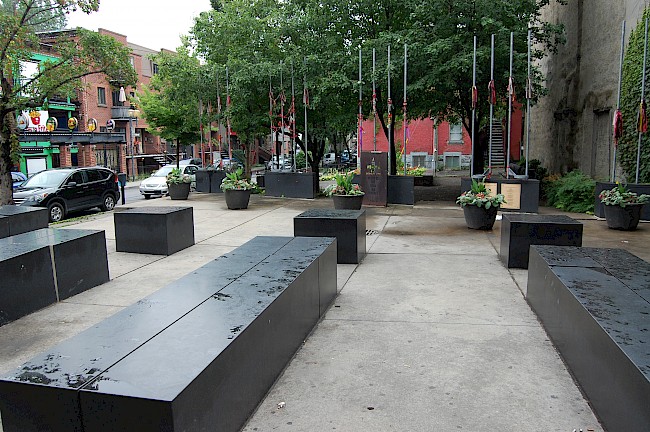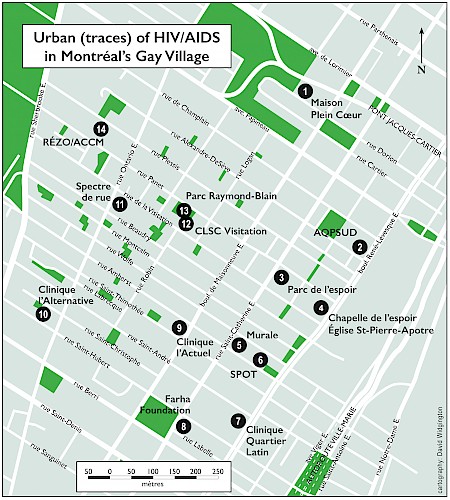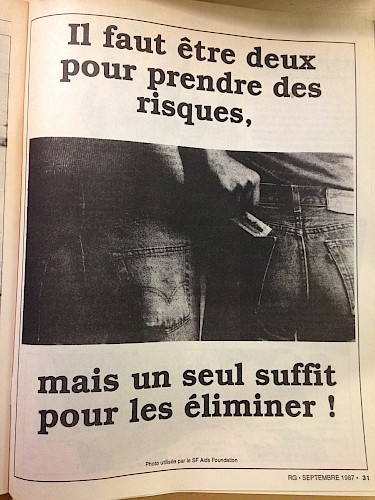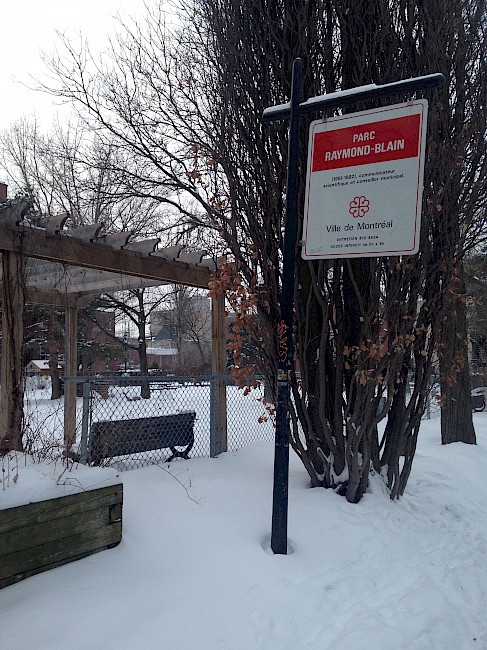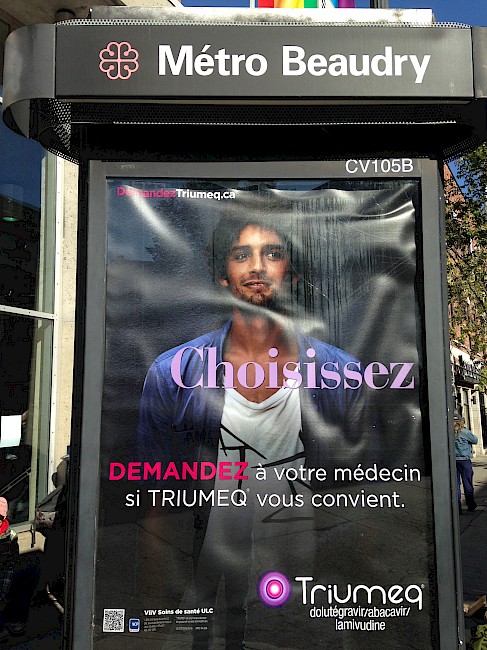Undetectable?
Looking for urban traces of HIV/AIDS in Montréal’s gay Village
—
Abstract
AIDS will disappear one day.
In the meantime, we have the opportunity to learn and to grow.
And we must do so.
In recent years, there has been increased depiction of the early AIDS epidemic through film: We Were Here (2011), United in Anger (2012), How to Survive a Plague (2012), Dallas Buyers Club (2013), and a recent HBO adaptation of The Normal Heart (2014). Paradoxically, this attention to the first years of the epidemic is concurrent with a discourse that emphasizes the ‘end of AIDS’, increasingly visible at scientific conferences, in public health plans, and in international recommendations.
A dramatic decrease in the number of new infections has emerged as the cornerstone of this global project to end AIDS, a goal, we are told, that could be reached in the coming decades. The goal of ‘zero transmission’ is made possible through the widespread use of antiretroviral (ARV) medication. It has been established that an HIV-positive person with an undetectable viral load cannot transmit the virus (Rodger et al. 2016). It has also been shown that pre-exposure prophylaxis (PrEP) – a medication taken by HIV-negative individuals who are particularly at risk – can reduce the risk of becoming infected (Grant et al. 2010).
At a time when we have the means to render HIV biologically undetectable in developed countries, we might ask: what is obscured in the space between these concurrent prominent discourses of nostalgia and biomedical promises? In this think piece, I explore other materialities of the virus: its social and historic inscription in urban spaces, in particular Montreal’s gay neighbourhood, known as ‘the Village’. I base this discussion on my fieldwork in Montreal, specifically in its gay village, since the spring of 2012. Having relocated to Québec from France, I chose to immerse myself in this environment as a way to allow new ideas to emerge. The field notes that lie at the heart of this text come mostly from my walks in the neighbourhood, but also from readings and discussions with local residents.
This attempt to develop an ‘archaeology of the contemporary’ is inspired in part by Lachenal and Mbodj-Pouye’s 2014 call to examine the material traces of the past, as well as how they are interpreted and what affects they summon. These writers focus on expressions of nostalgia for the colonial past in Africa, and suggest that an understanding of the ‘presence of the past’ allows us to develop larger questions about contemporary contexts (Lachenal and Mbodj-Pouye 2014, 7). For them, nostalgia should be thought of as a complex political affect, which brings together ‘an active practice of regret’ with stakes of ‘belonging and community’ and the ‘materiality of nostalgic attachments’ (ibid., 17–18).
At a time when the fight against HIV/AIDS relies almost exclusively on a narrative of biomedical intervention, I want to examine how the experience of the sickness is embodied in urban spaces. In exploring the material traces of the epidemic and the affects it has engendered, I articulate a critical analysis of the ways in which public health authorities imagine gays as a community affected by HIV. This epidemiological approach is a clear example of a ‘community’s viral load’ (Gagnon and Guta 2012).
Searching for traces of HIV
Montreal, 1 December 2013, 5 pm. The Parc de l’Espoir [The Park of Hope], dedicated to those who died of AIDS, is covered in snow. At the corner of rue Sainte-Catherine and rue Panet, the park is lined with large blocks of black granite that symbolize death. A rusty plaque commemorates the deaths of people in Québec due to AIDS. Around 50 people have gathered, many of them are holding candles. After a few brief speeches and a minute of silence, the participants tie red ribbons to one of the trees in the park. (Excerpt from fieldnotes)
In comparison to memorials for wars and armed conflicts, memorial sites in urban spaces for other causes of death are rare.[note 1] But among other deadly pathologies, HIV/AIDS is often exceptional. Over the last decades, monuments have been created to commemorate the victims of this particular disease around the world.[note 2]
The annual 1 December vigil, held on World AIDS Day, is one of the few public events in Montreal that commemorate those who died of AIDS. These gatherings also serve as a reminder that HIV is still a threat in Québec. Nearly four hundred cases of the virus are diagnosed every year in Quebec among men who have sex with men (ASPC 2014), mostly in the Montreal area (INSPQ 2014).[note 3]
The role of Parc de l’Espoir (see map, number 3) as a public memorial came into being following a long struggle by activists from ACT UP Montreal in the early 1990s. The park’s location in the gay village is a reminder of the impact the epidemic has had on gay communities.
Which Village?
Situated to the south and east of Montreal’s commercial downtown, the Village is a mixed space, in terms of its population, local cultures, and sexualities. New condominiums have been built alongside century-old rental buildings, and professional employees of Radio-Canada and the TVA television station share spaces with homeless individuals and university students. At night, the neighbourhood draws gay clients to its bars, saunas, and nightclubs.
Unlike the Marais neighbourhood in Paris, Montreal’s Centre-Sud has historically been (and remains) a working-class neighbourhood. The emergence of the Village between the Berri-UQÀM and Papineau metro stations began in the early 1980s (Hinrichs 2011; Giraud 2014). Among the earliest signs of this emergence was the establishment of diverse businesses, especially bars (Remiggi 1998).
The history of the Village is closely tied to the upheavals and tensions that accompanied the social acceptance of the gay community in Québec (Podmore 2015). The 1980s and 1990s were marked by clashes with the police. In July of 1990, a police raid of a nightclub called the Sex Garage led to rioting. In the days that followed, hundreds of protestors mobilized against police brutality in the streets of the Village. This episode launched a wider mobilization for LGBT rights in Québec. Since then, an LGBT pride march and associated events are held each summer in the Village.
Over the last decade, the neighbourhood has been the site of a subtler struggle, that of gentrification. Since 2012, media reports of homophobic violence in the Village have led to diverse reactions. In the press and in street protests, residents’ associations and business owners who favour increased police presence have clashed with queer groups who decry the neighbourhood’s gentrification (Pare and Fortier 2014; Barraud 2014). These political tensions illustrate the socioeconomic and generational diversity both in the Village and in individuals’ lived experiences of homosexuality.
Geographies of gay health
In the years that preceded the emergence of AIDS, the Village was already a site for health projects targeting gays. These include the Gay Social Service Project founded in 1975 and the Gai écoute phone line, which began operating in the 1980s. Both were supported by the Centre des services sociaux Ville-Marie (Dorais 1982). Yet, the Village has sometimes been a site of ambivalent solidarity. While the community has been at the forefront of organizing to fight HIV/AIDS, relationships between gay movements and AIDS movements have often been fraught (Lavoie 1998). The former are wary of being stigmatized by associations made between AIDS and homosexuality, while the latter seek to make AIDS an issue of general concern.
Those close to HIV-positive people proved to be the most active in mobilizing to support them. During the first years of the epidemic, accompanying the sick during their final days was an important priority. Several hospices remain active to this day, including Maison Plein Cœur on rue Dorion, which was founded in 1991. These new forms of support drew upon social bonds that formed between the neighbourhood’s residents (Lavoie 1998).
As sites for socialization and sexual encounters, gay establishments on rue Saint-Catherine seemed natural sites for AIDS-prevention activities. During its first information campaign in 1986, entitled ‘Jouez sûr/Play safe’, The Comité Sida Aide Montréal distributed pamphlets, condoms, and lubricants. Today, organizations such as RÉZO (previously Séro Zéro) and ACCM (AIDS Community Care Montreal) continue to play an important role in similar first-line interventions.
In the context of HIV prevention, substance-abuse treatment, sex work, and homosexuality were all connected to each other by the epidemic in the 1980s, but these connections have become less clear in recent years. In particular, the desire for respectability among certain segments of the gay community has motivated them to distance themselves from drug users and sex workers, who have remained persistently marginal at a time when middle-class homosexuality has become increasingly mainstream.
Traces of HIV
The Village has been a key site for medical and community mobilizations to fight HIV. During the 1980s, Montreal’s gay community was hit hard by AIDS, and shock and panic eventually gave way to action and solidarity. The Clinique l’Annexe, founded in 1984 (and renamed Clinique médicale l’Actuel in 1987) and focused on sexual health, quickly became an important site for health services for HIV-positive people. The clinic was first located on 1259 rue Berri, then moved to rue Maisonneuve. The Comité Sida Aide Montréal (C-SAM), founded in 1985, was Québec’s first community HIV/AIDS organization. Early members of C-SAM didn’t want it to be seen as a gay organization, which could explain why they chose to be located outside of the Village area (Schecter 1990). But most of their prevention activities, such as conferences and awareness campaigns, took place around rue Sainte Catherine. C-SAM would eventually lead to the creation of other organizations, including Séro Zéro, created in 1991 by and for gay and bisexual men. During the same period, free magazines distributed in the Village also contributed to HIV awareness; these included Sortie, Rencontres Gaies, and Fugues.
In July of 1989, Montreal hosted the 5th International AIDS Conference. This gathering of scientists and health authorities became the site of visible protests organized by ACT UP New York, AIDS Action Now!, and Réaction Sida, a Montreal-based organization. These organizations called for patients’ experiences, knowledge, and perspectives to be included in research and in the creation of public policies. During the conference, activists held a symbolic take-over of the convention centre, located a few hundred metres from the Village, marking the first time AIDS patients ‘broke into’ a medical conference. Subsequently, a branch of ACT UP was created in Montreal; it would remain active for the first half of the 1990s (Lavoie 1998).
ACT UP Montreal’s activists were extremely critical of official responses to the epidemic, which they considered to be negatively influenced by homophobia. Their anger also belied the anguish of individuals faced with a growing number of AIDS-related deaths (Lavoie 1998). In the heart of the Village, the Parc de l’Espoir remains a symbol of the early years of struggle. Located at the corner of rue Panet and rue Sainte-Catherine, the park was inaugurated on 1 December 1991 following an ACT UP demonstration. Protestors hung more than one thousand black ribbons in the park’s trees to commemorate those who had died. In the following days, the city of Montreal’s maintenance department removed the ribbons. This marked the beginning of a long struggle to make the park a memorial site. It would go on to become an important location for gay protests and demonstrations. In 1994, the city conceded to dedicating the park to the victims of AIDS. In 1996, a commemorative monument was unveiled, giving the park its current appearance.
The legacy of these dark years is also inscribed in subtler ways throughout the Village. For example, the Parc Raymond Blain (13) on rue Panet (between rue Lafontaine and rue Logan) was named in honour of the local city councillor, who was also the first openly gay candidate in Montreal (Podmore 2015). Known for his involvement in the fight against the epidemic, Blain died of AIDS in 1992, at the age of forty-one. A plaque in the park commemorates his life. A more surprising example is the Chapel of Hope, located in St. Pierre-Apôtre Catholic Church at the corner of rue de la Visitation and Boulevard René-Lévesque. The chapel is a site for remembrance and prayer, and a flame in honour of those who died of AIDS has burned there since 22 July 1996.
A large mural at the corner of rue Wolfe and rue Sainte-Catherine features the quotation by Ron Farha that opens this essay. Farha was a Montreal businessman who died of AIDS in 1993, shortly after creating the foundation that bears his name, with the primary goal of raising funds to support people living with HIV.
Current traces
Looking for traces of HIV in the Village means being attentive to contemporary uses of public spaces. Each year at the end of September, a public fundraiser called ‘Ça marche’, organized by the Farha Foundation, starts in the streets of the village. And each year on 1 December, the Parc de l’Espoir is the site of a candlelight vigil in honour of World AIDS Day. In a tribute to the park’s history, participants are invited to tie ribbons to the trees. These are the main public events related to HIV in Montreal.
Contemporary traces of HIV are also found in the community and care centres that are concentrated in the area. These include the CLSC (Local Health and Social Service Centre), 1705 rue Visitation (12); the clinics Clinique l’Actuel (9) (1001 de Maisonneuve-est), l’Alternative (10) (2034 rue Saint-Hubert), and Quartier Latin (7) (905, Boulevard René-Lévesque est); and the community organizations RÉZO and ACCM (14) (2075 rue Plessis), SPOT, a rapid-test and counselling centre (6), and the Maison Plein Cœur (1) (1611 rue Dorion). Traces of HIV are also present in groups working in the field of substance abuse: the Association Québécoise pour la promotion de la santé des personnes utilisatrices de drogues (2) (AQPSUD, 1555 Boulevard René-Lévesque) and Spectre de rue (11) (1280 rue Ontario). Finally, the Farha Foundation is located at 572 rue Sainte-Catherine (8).
On a smaller scale, HIV is present in the Village in the form of prevention documents, posters, packets of condoms and lubricant, and occasional advertisements by pharmaceutical companies.
HIV and affects in the city
Searching for material traces that engender affects involves imagining a diverse array of emotions, including anger and indignation, sadness and melancholy. The traces of HIV in the neighbourhood also reflect different forms of hope, as expressed by the quotation in the mural that ‘AIDS will disappear one day’. This phrase takes on new meanings at a time when various projects aim to eradicate the virus. The end of the quotation, ‘And in the meantime we have the opportunity to learn and to grow, and we must do so’, highlights the extent to which this hope involves working on oneself in the present.
A site such as the Parc de l’Espoir brings together this range of affects. As a site of commemoration and struggle, it is also a space that draws people together when Montreal’s harsh winters turn to spring. I myself have stopped there often, sometimes for just a few minutes, sometimes staying longer. From May to September, the closing of rue Sainte-Catherine to vehicle traffic turns the park into a gathering place for tourists and locals, in a mix of ages and genders. The blocks of granite that represent tombs on 1 December become public benches. Seated, standing, or lying on them, people observe, rest, and cruise during the heat of the day and in the still of the evening. In the summer, a public piano contributes to an atmosphere that can be both intimate and cheerful.
In this way, Parc de l’Espoir not only is a marker of collective trauma but also represents carefree aspects of life, unlike war, slavery, or Holocaust memorials. In a community where the transmission of memories rarely takes place within biological or traditional families, the park makes visible a tragic past. But it also illustrates, nearly twenty years after the emergence of highly active antiretroviral therapies (HAART), the generational cleavages in experiences with and of AIDS. The traumas related to the disease and its effects on gay lives are differently lived and embodied by those who knew the world before AIDS, those born at the height of the epidemic, and those born after HAART.
Nostalgia(s)
Emotions are also manifested in nostalgia and longing, both of which are key when considering the traces of HIV in the Village. There is nostalgia for a neighbourhood that is changing rapidly and for the forms of solidarity that developed in response to police repression, and for the collective affirmation of a minority identity via a shared collective myth.
The legal recognition of homosexuality and the achievement of equal rights under the law in 2005, as well as a provincial program to fight homophobia, are seen as markers of increased social acceptance of gays and lesbians. Even more importantly, gay social life has been dematerialized over the past fifteen years. Identity formation; coming out; and the development of platonic, sexual, and loving relationships are increasingly mediated by Internet technologies, leading to a progressive decline of businesses in the Village, as in other gay neighbourhoods across the world (Nash and Gorman-Murray 2015).
Nostalgia is also traceable in memories of darker chapters of the epidemic. These have been the subjects of the many recent films and documentaries mentioned above. Focusing on the earliest mobilizations against AIDS, these works depict not only the shock and anguish of those difficult years, but also the solidarity and commitments that subsequently developed. A narrative of the 1980s and of the early struggles against AIDS emerges, one of fascination, of passing the torch, and of compassion. Yet, nostalgia has ambivalent effects; it celebrates certain features of the past while glossing over others – the precarious situation of HIV-positive people, the loneliness faced by older gay men whose networks were decimated by the disease, and the high rate of new infections among gay and bisexual men in Québec.
Nostalgia for what the Village used to be and nostalgia about AIDS are sometimes intertwined in mythical memories of past collective struggles. The gradual disappearance of common enemies – police repression, homophobia, the worst impacts of the epidemic – sometimes blurs contemporary understandings of what builds community. But the dialectic of appropriation and disappropriation of AIDS by gay men in this history also plays a role. The AIDS epidemic served as a springboard for gay and lesbian rights in Quebec. But starting in the 1990s, the struggle for the social acceptance of homosexuality broke off from issues related to health (Lavoie 1998). Following distinct but parallel trajectories, the normalization of AIDS and the normalization of homosexuality played off each other, attenuating the traumatic effects of the epidemic.
Exploring other materialities of HIV/AIDS
Treatment as prevention today constitutes a field for action, intervention, activism, and major financial investment for actors in the fight against HIV. Concepts such as eradication or cure, which seemed impossibly futuristic just a few years ago, are now at the heart of public health discourse and practices.
The foreseeable potential for eradicating HIV has redrawn the map of public health concerns (Nguyen et al. 2011). The biological and cellular materialities of the infection are at the heart of treatment-based prevention strategies. But these are also accompanied by a redefinition of treatment sites and vulnerable populations, which are implicit in the notion of community viral load (Gagnon and Guta 2012). This is highlighted by a renewed interest in the Village as a site for public health research projects, whether related to rapid testing (the SPOT project or the Clinique l’Actuel), to PrEP (the IPERGAY drug trial), or access to combined prevention (Project Mobilise!). These projects are based on the convergence of viral cartographies (the Village as a site of not only infection but also of testing and care) and political cartographies (the Village as a space of community mobilization).
These projects confront the inherent tension – identified by Marx for class issues – between the community ‘in itself’ (defined by public health and epidemiology) and the community ‘for itself’ (an aware and mobilized social group). This construction of a community concerned with HIV thus participates in new forms of governance of risk and sexuality. While they are laudable as public health projects, their creators and implementers must take seriously the historicity and the diversity of how HIV has been anchored in the neighbourhood and in the gay community. In this context, the inclusion of community-based approaches in these research projects run the triple risk of homogenizing the target groups, erasing others (such as trans people), and omitting the lived realities of the individuals in question (Namaste 2015).
Acknowledgments
I’m grateful to the participants of the Q3S (Québec sciences sociales et santé) writing group for their comments on and supportive critiques of this text: Maud Arnal, Michèle Barrère-Dion, Baptiste Brossard, Baptiste Godrie, Annie Jaimes, Annie Larouche, and Pierre Minn. I’m also grateful to David Widgington, undisciplinary activist and cartographer, who drew the map of the Village (burningbillboard.org).
About the author
Gabriel Girard is a medical sociologist and postdoctoral fellow at the Public Health Institute of Research of Montreal University, Canada (Institut de recherche en santé publique de l’Université de Montréal). He conducts research on risk, sexuality, and HIV prevention issues in French-speaking contexts. Visit Gabriel’s blog for more on his research activities: www.gabriel-girard.net.
References
Barraud, Sébastien. 2014. ‘Pink Bloc et Carrés roses: Une même couleur pour quelles nuances?’ Fugues, 22 February.
Dorais, Michel. 1982. ‘Mouvement social gai et luttes institutionnelles: des services sociaux pour les personnes d'orientation homosexuelle’. Revue internationale d'action communautaire 7, no. 47: 132–35. https://doi.org/10.7202/1035019ar.
Gagnon, Marilou, and Adrian Guta. 2012. ‘Mapping HIV Community Viral Load: Space, Power and the Government of Bodies’. Critical Public Health 22, no. 4: 471–83. https://doi.org/10.1080/09581596.2012.720674.
Giraud, Colin. 2014. Quartiers gays. Paris: Presses Universitaires de France.
Grant, Robert, Javier R. Lama, Peter L. Andersen, Vanessa McMahan, Albert Y. Liu, et al. 2010. ‘Preexposure Chemoprophylaxis for HIV Prevention in Men Who Have Sex with Men’. New England Journal of Medicine 363, no. 27: 2587–99. https://doi.org/10.1056/nejmoa1011205.
Hinrichs, Donald. 2011. Montreal’s Gay Village. Bloomington, IN: IUniverse.
Lachenal, Guillaume, and Aïssatou Mbodj-Pouye. 2014. ‘Restes du développement et traces de la modernité en Afrique’. Politique Africaine 135: 5–21. https://doi.org/10.3917/polaf.135.0005.
Lavoie, René. 1998. ‘Deux solitudes: les organismes sida et la communauté gaie’, in Sortir de l'ombre: Histoires des communautés lesbienne et gaie de Montréal, edited by Irene Demczuk and Frank Remiggi, 337–62. Montréal: VLB éditeur.
Namaste, Viviane. 2015. Oversight: Critical Reflections on Feminist Research and Politics. Toronto: Women’s Press.
Nash, Catherine Jean, and Andrew Gorman-Murray. 2015. ‘Recovering the Gay Village: A Comparative Historical Geography of Urban Change and Planning in Toronto and Sydney’, Historical Geography 43: 84–105.
Nguyen, V.-K., N. Bajos, F. Dubois-Arber, J. O'Malley, and C. M. Pirkle. 2011. ‘Remedicalising an Epidemic: From HIV Treatment as Prevention to HIV Treatment Is Prevention’. AIDS 25, no. 3: 291–93. https://doi.org/10.1097/qad.0b013e3283402c3e.
Paré, Isabelle, and Fortier, Marco. 2014. ‘Climat de peur dans le Village’. Le Devoir, 25 January. Accessed 8 December, 2016. http://www.ledevoir.com/societe/actualites-en-societe/398166/climat-de-peur-et-violence-dans-le-village-gai.
Podmore, Julie. 2015. ‘From Contestation to Incorporation: LGBT Activism and Urban Politics in Montreal’, in Queer Mobilizations: Social Movement Activism and Canadian Public Policy, edited by Manon Tremblay, 187–207. Vancouver: UBC Press.
Remiggi, Frank. 1998. ‘Le Village gai de Montréal: entre le ghetto et l’espace identitaire’, in Sortir de l'ombre: Histoires des communautés lesbienne et gaie de Montréal, edited by Irene Demczuk and Frank Remiggi, 267–90. Montreal: VLB éditeur.
Rodger, Alison, Valentina Cambiano, Tina Bruun, Pietro Vernazza, Simon Collins, et al. 2016. ‘Sexual Activity without Condoms and Risk of HIV Transmission in Serodifferent Couples When the HIV-positive Partner Is Using Suppressive Antiretroviral Therapy’. JAMA 316, no. 2: 1–11. https://doi.org/10.1001/jama.2016.5148.
Schecter, Stephen. 1990. The AIDS Notebooks. Albany: State University of New York Press.
UNAIDS. 2014. ‘Ending the AIDS Epidemic by 2030’. http://www.unaids.org/sites/default/files/media_asset/JC2686_WAD2014report_en.pdf.
Endnotes
1 Back
In Montreal, another example is the memorial to the thirteen thousand Irish workers who died of typhus during the construction of the Victoria Bridge in the nineteenth century.
2 Back
See the website: http://www.aidsmemorial.info/.
3 Back
The HIV prevalence rate in this population is approximately 13 percent (Argus 2012), which is fifty-six times greater than in the general population.
